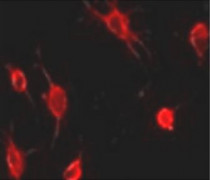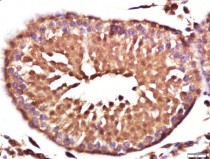ARG65786
anti-Vinculin antibody
anti-Vinculin antibody for ICC/IF,IHC-Formalin-fixed paraffin-embedded sections and Human,Mouse,Rat
Cell Biology and Cellular Response antibody; Controls and Markers antibody; Signaling Transduction antibody; Loading Control antibody; Loading Control antibody for cytoplasmic fraction; High MW loading control antibody
Overview
| Product Description | Rabbit Polyclonal antibody recognizes Vinculin |
|---|---|
| Tested Reactivity | Hu, Ms, Rat |
| Tested Application | ICC/IF, IHC-P |
| Host | Rabbit |
| Clonality | Polyclonal |
| Isotype | IgG |
| Target Name | Vinculin |
| Antigen Species | Human |
| Immunogen | Synthetic peptide around aa. 1010-1060 of Human Vinculin. |
| Conjugation | Un-conjugated |
| Alternate Names | HEL114; Metavinculin; CMH15; Vinculin; CMD1W; MV; MVCL |
Application Instructions
| Application Suggestion |
|
||||||
|---|---|---|---|---|---|---|---|
| Application Note | IHC-P: Antigen Retrieval: Boiling in Sodium citrate buffer (pH 6.0) for 15 min. * The dilutions indicate recommended starting dilutions and the optimal dilutions or concentrations should be determined by the scientist. |
Properties
| Form | Liquid |
|---|---|
| Purification | Purification with Protein A. |
| Buffer | Aqueous buffered solution, 0.09% Sodium azide, 1% BSA and 50% Glycerol. |
| Preservative | 0.09% Sodium azide |
| Stabilizer | 1% BSA and 50% Glycerol |
| Concentration | 1 mg/ml |
| Storage Instruction | For continuous use, store undiluted antibody at 2-8°C for up to a week. For long-term storage, aliquot and store at -20°C. Storage in frost free freezers is not recommended. Avoid repeated freeze/thaw cycles. Suggest spin the vial prior to opening. The antibody solution should be gently mixed before use. |
| Note | For laboratory research only, not for drug, diagnostic or other use. |
Bioinformation
| Database Links | |
|---|---|
| Gene Symbol | VCL |
| Gene Full Name | vinculin |
| Background | Vinculin is a cytoskeletal protein associated with cell-cell and cell-matrix junctions, where it is thought to function as one of several interacting proteins involved in anchoring F-actin to the membrane. Defects in VCL are the cause of cardiomyopathy dilated type 1W. Dilated cardiomyopathy is a disorder characterized by ventricular dilation and impaired systolic function, resulting in congestive heart failure and arrhythmia. Multiple alternatively spliced transcript variants have been found for this gene, but the biological validity of some variants has not been determined. [provided by RefSeq, Jul 2008] |
| Function | Actin filament (F-actin)-binding protein involved in cell-matrix adhesion and cell-cell adhesion. Regulates cell-surface E-cadherin expression and potentiates mechanosensing by the E-cadherin complex. May also play important roles in cell morphology and locomotion. [UniProt] |
| Cellular Localization | Cytoplasm |
| Research Area | Cell Biology and Cellular Response antibody; Controls and Markers antibody; Signaling Transduction antibody; Loading Control antibody; Loading Control antibody for cytoplasmic fraction; High MW loading control antibody |
| Calculated MW | 124 kDa |
| PTM | Phosphorylated; on serines, threonines and tyrosines. Phosphorylation on Tyr-1133 in activated platelets affects head-tail interactions and cell spreading but has no effect on actin binding nor on localization to focal adhesion plaques (By similarity). Acetylated; mainly by myristic acid but also by a small amount of palmitic acid. |
Images (2) Click the Picture to Zoom In
-
ARG65786 anti-Vinculin antibody ICC/IF image
Immunofluorescence: 4% paraformaldehyde fixed (15 minutes) MG63 cells permeabilized by 0.1% Triton X- 100 (15 minutes) and then stained with ARG65786 anti-Vinculin antibody (red) at 1:100 dilution.
-
ARG65786 anti-Vinculin antibody IHC-P image
Immunohistochemistry: Paraformaldehyde-fixed, paraffin embedded Rat testis; Antigen retrieval by boiling in sodium citrate buffer (pH6.0) for 15 min; Block endogenous peroxidase by 3% hydrogen peroxide for 20 min; Blocking buffer (normal goat serum) at 37°C for 30 min; Antibody incubation with ARG65786 anti-Vinculin antibody at 1:400 overnight at 4°C, followed by a conjugated secondary for 20 min and DAB staining.







